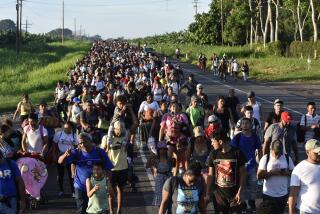Blasts targeting civilians kill seven
MEXICO CITY — Mexican authorities blamed organized crime Tuesday for a pair of blasts that killed at least seven people and injured more than 100 during Independence Day festivities in a western state.
The explosions, which officials believed were caused by fragmentation grenades, ripped through crowds in the capital of Michoacan state late Monday night during the traditional cry of independence, or grito.
The violence jolted a Mexican population already unnerved by the rising death toll from the nation’s drug war, and raised fears that it might represent the start of a Colombia-style terrorism campaign by drug traffickers. No one claimed responsibility.
Although a growing number of civilians have been caught in the crossfire of the drug violence, traffickers have not previously targeted them.
Some analysts saw the attack as a means of pressuring the government of President Felipe Calderon to back away from its 21-month-old campaign against drug-trafficking groups.
“They have been hit hard by the Calderon administration and this is the way they respond -- to generate fear in the Mexican population,” said Jorge Chabat, a Mexico City-based security analyst. “The purpose . . . is to increase the political cost to Calderon of going after the cartels.”
Mexican leaders said the attack intentionally targeted civilians.
“We have no doubt this is an act of terrorism,” Michoacan Gov. Leonel Godoy, who was presiding over the grito in the city of Morelia but was not hurt, said in a statement.
In a television interview, Godoy said organized-crime elements appeared to have been responsible. But he did not provide evidence, or say which group was believed involved.
Godoy said the blasts were apparently caused by fragmentation grenades. Hit men for drug-trafficking organizations have at times employed the grenades against police and to intimidate foes.
If Godoy is right, attackers chose to make a powerful statement by launching an Independence Day attack on Michoacan, Calderon’s home state.
Calderon’s government began a crackdown against organized crime after taking office in December 2006. He has sent 40,000 troops and 5,000 federal police officers into the streets as part of the push, which has aggravated violent feuding among drug gangs.
More than 3,000 people have died this year in drug-related violence, according to unofficial tallies by the Mexican news media.
Calderon condemned the blasts as cowardly and called on Mexicans to unite.
“These are abominable acts that were clearly attacking our national security, committed by real traitors who have no respect for others or the nation,” Calderon said Tuesday during a wreath-laying ceremony in Mexico City that was among Independence Day celebrations held nationwide.
Calderon urged Mexicans to step forward with information that could help authorities catch those responsible.
The explosions created pandemonium during one of Mexico’s most beloved celebrations. The grito, a flag-waving commemoration of the 1810 declaration of war to break from Spanish rule, is held in plazas all over Mexico on Sept. 15, the eve of Independence Day.
Images of the scene in Morelia, the Colonial-era state capital, resembled those of bombing attacks in the Middle East, with rescue workers scrambling to reach the wounded and dazed. Empty shoes and scraps of clothing were strewn about the bloody pavement of the city’s tree-lined main plaza, where thousands had gathered for the “Viva Mexico!” cry.
Most of the victims died during the initial blast at the plaza. A second explosion occurred a few blocks away on a crowded street. Officials said 108 people were hurt, at least 15 severely.
Godoy said witnesses reported that at least one of the grenades was thrown by a heavyset man dressed in black, who begged forgiveness for what he was about to do.
On Tuesday, authorities canceled the Independence Day parade in Morelia and army troops stood guard at the plaza.
Godoy said the federal attorney general’s office was taking over the investigation. The attorney general oversees investigations of drug trafficking, organized crime and terrorism.
Michoacan, long a drug-trafficking center, was the first state targeted in Calderon’s military-led crackdown. Anti-drug operations have continued, but the violence there has been eclipsed in recent months by rising death tolls in other spots, such as the northern border state of Chihuahua and the western state of Sinaloa.
U.S. law enforcement officials say the Calderon offensive has roiled the violent drug underworld by making it more difficult to smuggle narcotics north toward the United States. Michoacan is one place where U.S. officials say the effort has disrupted smuggling.
The bloodshed marred Mexico’s independence celebrations.
In Mexico City, thousands of residents lined up for the annual military parade along the Paseo de la Reforma. But amid the flag waving, there was anger and unease.
Francisco Sandi, a 21-year-old student, said the incident underscored the dilemma facing Mexican leaders over drug trafficking.
“I ask myself, what’s better? That the police intervene and provoke this kind of violent response from the narcos,” he said, “or do nothing and end up being accomplices?”
--
Times staff writer Deborah Bonello and Cecilia Sanchez of The Times’ Mexico City Bureau contributed to this report.
More to Read
Sign up for Essential California
The most important California stories and recommendations in your inbox every morning.
You may occasionally receive promotional content from the Los Angeles Times.










